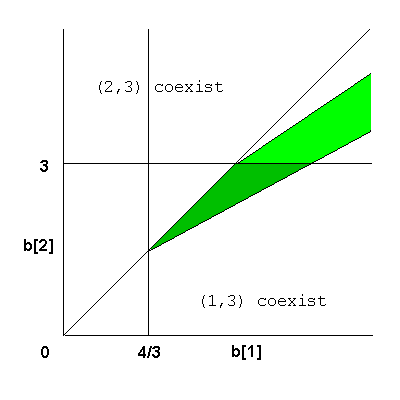
Here the possible states are 0 = vacant, 1, 2 = two prey species, 3 = predator.
Types i = 1, 2 behave like a contact process, dying at a constant rate d[i] and being born at vacant sites at rate b[i] times the fraction of neighbors in state 1.
3's die at a contant rate d[3], are born at sites occupied by 1's at at rate b[3] times the fraction of neighbors in state 3. and are born at sites occupied by 1's at at rate b[4] times the fraction of neighbors in state 3.
Finally, there is stirring at rate nu: for each pair of neighboring sites x and y we exchange the values at x and at y at rate nu.
In the absence of predators, this system reduces to the competing contact process, where the stronger species (identified by the larger of the two ratios b[i]/d[i]) will competitively exclude the other. However, if the predators feeding rate on the stronger species is larger, its presence may stabilize the competition between the two species.
One way of seeing this is to consider the mean field ODE:

Here one can solve three equations in three unknowns to find conditions for an interior fixed point but a more frutiful approach is to derive conditions from an invadability analysis. Half of this may be described as follows.
By results for predator prey systems, 2's and 3's can coexist if (b[2]-d[2])/b[2] > d[3]/b[4] and when this holds their equilibrium densities will be v[2] = d[3]/b[4] and

Examining the behavior of the ODE near (0,v[2],v[3]) we see that 1's can invade the (2,3) equilibrium if
b[1] - d[1] - b[1]v[2] - ( b[1] + b[3] )v[3] > 0
In a similar way one can derive conditions for the (1,3) equilibrium to exist and for the 2's to be able to invade it. When both sets of conditions hold we say there is mutual invadability. It is easy to prove that in this case that the ODE has an interior fixed point. By extending the methods of Durrett (1993), Nikhil Shah (1997) has shown
Theorem. If mutual invadability holds then coexistence occurs fo fast stirring.
To get a feel for the resulting phase diagram, set b[3] = 4, b[4] = 3/2, all the d[i] = 1, and vary b[1] and b[2]. The formulas above imply that 1 and 3 coexist if b[1] > 4/3, 2 and 3 coexist if b[2] > 3, and finally all three species can coexist inside the region bounded by the equations

The last few lines can be summarized in the following picture:

Note that there is a region where all three species can coexist but 2's and 3's cannot. Upon reflection this is not surprising: it simply says the 2's are not a sufficiently good food source to maintain the predator by themselves.
s3 Exercise. For a concrete example of predator mediated coexistence in our spatial model, run the model with its default values: b[1] = 4, d[1] = 1, b[2] = 3, d[2] = 1, b[3] = 4, b[4] = 1.5, d[3] = 1, fraction of stirring steps = 0.5. This is one of the points in our picture above. Searching for your own values for which coexistence occurs should give you an appreciation of the information about the phase diagram in the theorem.
s3 Footnote. To increase the effect of single stirring steps we exchange the value at x with a site y chosen at random from the square of radius 3 centered at x.
Durrett, R. (1993) Predator-prey systems. Pages 37--58 in Asymptotic problems in probability theory: stochastic models and diffusions on fractals. Edited by K.D. Elworthy and N. Ikeda, Pitman Research Notes 83, Longman Scientific, Essex, England
Shah, N. (1997) Predator-mediated coexistence. Ph.D. Thesis Cornell U. In preparation.